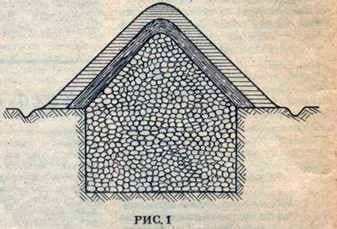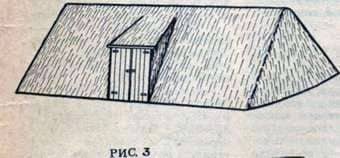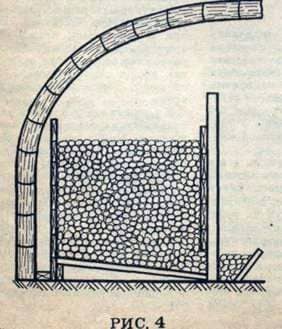
The room for storage of root crops should be dry. In a wet cellar for a long time you will not save any potatoes, carrots or beetroot, a day or two later you will have to throw out rot. In the equipped storage facility, the pledged product must be protected not only from groundwater and atmospheric precipitation, but also from its own vapors that can condense on its surface under certain conditions, which leads to molding and decay. To prevent this, the room should be ventilated and do not allow significant temperature fluctuations. When the roots are kept dense solid mass in pits or piles, excess moisture can pick up sand, which is poured potatoes or beets.
Storage of root crops in piles in practice is common. When the soil is rather dry and dense, the product is laid simply in a pit dug in the ground, which protects it from freezing in cold winters. In Fig. 1 is a cross-sectional view of such a potato pit, which can generally be used to store virtually all root crops. It is advisable to do it with a slope (1: 5) for better filling. The width of the pit from the top is 3-3.5 m, the depth is up to 1.5 m. As a rule, it is made up to 2 m wide and at least a meter deep. The top of the pile can protrude above the ground level by about 1.5-1.7 m.
When the ground waters lie close and the pit can not be excavated, it is better to make root crops in a pile, a shoulder or a kagat. Such a pile is shown in Fig. 2. It has a basis width of 2-2.5 m at the same height. Around the piles, as well as the pits, it is necessary to dig up the drainage ditches.
It should be borne in mind that due to subsidence, the height of the pile can be reduced by almost a third, so it is necessary to make it accordingly larger in advance.

Most often pits and piles are covered with a layer of straw 20-35 cm, and then they fill the earth with clay and clay with a thickness of at least 30 cm, but not more than 50-60 cm. A very large bed of soil very hampers the product and makes it difficult to select, covering the layers of straw 15 cm and land 20 cm, which alternate. Covering all this with straw on top, as some people sometimes do, should not and even is harmful, as the straw, becoming wet, becomes more heat-conducting and cools the storage.
For ventilation in the pit or pile, a longitudinal horizontal channel is arranged. To do this, in the upper part of the straw layer, lay a smooth log in advance, which is then carefully removed. With the same purpose it is possible to use a wooden lattice of a triangular shape. Even better, when the same ventilation is arranged at the bottom of the pile. Do not do vertical ventilation ducts in any case, because the storage in them can get atmospheric moisture, which will lead to decay of the product.
All such stores, as well as the Kagats, suit when you do not need to regularly choose from there root crops. When such a need exists, it is better to make a simple roof in the vault with rafters covered with straw, reeds or other heat-insulating material, and a specially equipped entrance.

In the end, potatoes or beets can be stored in narrow long pits or trenches with a depth and width of up to a meter. In parallel, the placed moats are digged about 2 m apart from each other. Root crops are laid in a trench for equal land or centimeters 40 higher. From above arrange a ventilation channel from boards or wooden lattices, and all it cover with layers of straw and the earth, as it is described above. But it should be borne in mind that a small depth of trenches and a relatively thin shelter can not protect root crops from severe frost, so this method of storage is advisable to apply only in areas with a relatively warm climate.
Unfortunately, all these types of storage facilities – pits, piles, collars or kagats – do not always ensure proper storage of products, because it is difficult to achieve the best ratio of humidity and temperature. From this point of view, it is better to arrange permanent storage in basements, especially for products that are demanding of storage conditions than potatoes or beets.
But wherever products are stored, an important condition is the temperature in the storehouse and the humidity of its air.
The temperature of the product that persists tends to rise due to self-heating, which leads, on the one hand, to more intense decay, when high humidity, and from the second, to germination of the tubers, which starts already at 7 њ C. Therefore, while retaining large reserves of root crops, it is necessary to closely monitor the temperature. It should be as constant as possible, and in winter change within no more than 2-3 њ C, without sinking below zero in the greatest frosts. In the premises for storing fruits, the boundary of thermal vibrations can be considered 7-10 њ C.
When the temperature in the root store increases to 6-7 њ C, it should be artificially reduced by opening the ventilation holes or door for a short time. This airing is better to conduct for dry and not very frosty weather. When conditions permit, it is useful to shovel the product throughout.
Air humidity is controlled by special devices and maintained at an appropriate level by airing the storage. When it is not possible to reduce it in this way, sometimes use hygroscopic substances, the most accessible of which is quicklime or hydrochloric acid lime. It should be borne in mind that quicklime can be used only in storage for root crops; for fruit it is not suitable, because, in addition to moisture, it also absorbs from the air also the carbon dioxide necessary to maintain the maturation processes that are prolonged in the collected fruits. It is appropriate to point out that in the fruit storehouses the humidity of air, although it should not be the highest 80%, but its inadequacy leads to shrinking and wrinkling of fruits, which is not desirable at all.
In addition to humidity and temperature fluctuations, sunlight also contributes to the growth of the sun, which promotes germination, so the storage space for root crops should be as dark as possible. Vegetables and fruit light does not harm.
What size should the storage be? This, of course, depends on the amount of product that is put into storage. So, we can assume that 1 cu. A meter of storage is sufficient to store 800 kg of potato tubers. Roots, such as beetroots, carrots, etc., need a room more than about a half, through the higher moisture content in them.
It is possible to correlate the volume of storage with the area sown. So, for storage of a crop of a potato from one hectare it is necessary approximately 15-17, and fodder roots – up to 23. ЛХВ. meters. When the storage is designed exclusively for the storage of root crops for livestock feeding, up to 3 m3 of room volume is allocated to each head.
The internal height of the cellars reaches 2.5-2.8 g, but when they have a continuous vault, near the walls this height can not exceed 1.7 g.
Basements are built underground or semi-underground (with a high level of groundwater). In the latter case, it is better, however, to completely abandon the construction of the storage facility, since its high humidity is imminent. In general, for the construction of underground storage facilities, it is necessary to choose as possible dry and dense clayey clayey-sandy soil with a deep bed of groundwater. To protect against the effects of sunlight, it is advisable to plant a building with lilac bushes, elderberries, acacia or hawthorn. Rain water should be well diverted by natural slopes of the terrain and gutters, and the highest level of groundwater should be lower than the basement’s forgery by at least 0.5 g. The wet ground under the basement must be drained with drainage, which is laid under the storage floor at a depth of at least 0.6 grams
But in any storehouse, a great role in protecting it from moisture will be played by the construction of the floor, it is made from well-dried boards lined with tarred lags, with mandatory ventilation of the underground, or, much better, laid out of brick, stone or concrete slabs in cement mortar. For areas with a warm and dry climate, it is possible to make a concrete floor 10-15 cm thick, which is placed in a 20-cm thick well-tamped clay. It is even better to use asphalt.
Walls of basements are reduced by common rules with obligatory heat and waterproofing.
In above-ground storage of walls it is better to make stone, brick or concrete, not forgetting about the thermal insulation, which is especially needed here. In areas with a dry climate, you can use for this and Saman. Vaults for fruits, especially delicate ones, are usually made of stone or concrete.
You can make small windows in the walls, but it is better not to do this, especially for root crops.
The door of storage facilities should generally go to the south and only when storing fruits – to the north, since they need more humidity of air. It is desirable that the door was double, covered with heat-insulating material, and tightly closed, as in ordinary cellars or cellars.
For the roof it is better to use straw, reed, tes, roofing felt or roofing felt. In semi-underground and underground storages you can make a simple gable roof, covering it with straw, reeds or a thick layer of soil with the next dernow.
For the ventilation of the cellars, simple douche-boxes are installed, or chimneys with shutters are mounted. The size and number of such pipes or channels is determined by calculating that for each cubic meter of storage, 30 cm2 of their transverse section is needed.

If they save a large number of root crops and tubers, they fall asleep in boxes or bins. In Fig. 4 is a schematic cross-sectional view of such a notch. For better preservation of the product, it is separated from the wall by a wooden partition, and from below has a flooring of boards, located at an angle to the floor. Thanks to this, not only the root crops are ventilated better, but it is more convenient to choose them when the hole at the bottom of the notch is left. For the front wall, the pillars are firmly embedded from the forgery at a certain distance from each other, and boards are laid between them as the tubers or roots fall asleep. Tightly fit boards should not be, since the slots assist in better “ventilation.
Roots and vegetables, which are kept in small quantities (parsley, celery, etc.), it is more advisable to keep on shelves with sides, pouring dry sand, and cabbage on trellised shelves, placed in several tiers. When cabbage is a little, you can just hang it to the ceiling.
At the end it should be said that any room for storing root vegetables, fruits and vegetables should be carefully cleaned before dusting and cleaned of dust and mold, after which it is useful to smoke – gray, tightly closing all the openings.
Покровы тела пчелы. Обработка пчел щавелевой кислотой весной.
Useful tips for the amateur beekeeper